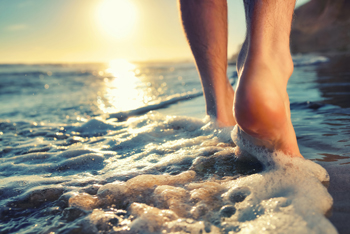Tarsal tunnel syndrome o ccurs when the tibial nerve in the tarsal tunnel gets squeezed or pressed, resulting in multiple issues. This narrow tunnel in the ankle, next to the ankle bone, serves as a pathway for nerves, veins, arteries and tendons. Risk factors for tarsal tunnel syndrome include having flat feet, muscle tightness, an abnormal structure like a cyst or tumor in the foot, trauma, or systemic diseases such as diabetes. Common symptoms of tarsal tunnel syndrome include pain on the inside of the ankle, a shooting sensation that can radiate up the ankle, and numbness or tingling along the sole of the foot. Those who believe that they may be suffering from tarsal tunnel syndrome should consult with a podiatrist immediately in order to prevent future damage. There are a variety of both surgical and nonsurgical treatment options and your podiatrist will determine what course of action is best for you.
ccurs when the tibial nerve in the tarsal tunnel gets squeezed or pressed, resulting in multiple issues. This narrow tunnel in the ankle, next to the ankle bone, serves as a pathway for nerves, veins, arteries and tendons. Risk factors for tarsal tunnel syndrome include having flat feet, muscle tightness, an abnormal structure like a cyst or tumor in the foot, trauma, or systemic diseases such as diabetes. Common symptoms of tarsal tunnel syndrome include pain on the inside of the ankle, a shooting sensation that can radiate up the ankle, and numbness or tingling along the sole of the foot. Those who believe that they may be suffering from tarsal tunnel syndrome should consult with a podiatrist immediately in order to prevent future damage. There are a variety of both surgical and nonsurgical treatment options and your podiatrist will determine what course of action is best for you.
Tarsal tunnel syndrome can be very uncomfortable to live with. If you are experiencing tarsal tunnel syndrome, contact Frank Henry, DPM of Marble Falls, TX. Our doctor can provide the care you need to keep you pain-free and on your feet.
Tarsal Tunnel Syndrome
Tarsal tunnel syndrome, which can also be called tibial nerve dysfunction, is an uncommon condition of misfiring peripheral nerves in the foot. The tibial nerve is the peripheral nerve in the leg responsible for sensation and movement of the foot and calf muscles. In tarsal tunnel syndrome, the tibial nerve is damaged, causing problems with movement and feeling in the foot of the affected leg.
Common Cause of Tarsal Tunnel Syndrome
- Involves pressure or an injury, direct pressure on the tibial nerve for an extended period of time, sometimes caused by other body structures close by or near the knee.
- Diseases that damage nerves, including diabetes, may cause tarsal tunnel syndrome.
- At times, tarsal tunnel syndrome can appear without an obvious cause in some cases.
The Effects of Tarsal Tunnel Syndrome
- Different sensations, an afflicted person may experience pain, tingling, burning or other unusual sensations in the foot of the affected leg.
- The foot muscles, toes and ankle become weaker, and curling your toes or flexing your foot can become difficult.
- If condition worsens, infections and ulcers may develop on the foot that is experiencing the syndrome.
A physical exam of the leg can help identify the presence of tarsal tunnel syndrome. Medical tests, such as a nerve biopsy, are also used to diagnose the condition. Patients may receive physical therapy and prescriptive medication. In extreme cases, some may require surgery.
If you have any questions please feel free to contact our office located in Marble Falls, TX . We offer the newest diagnostic and treatment technologies for all your foot and ankle needs.







 Flip-flops
Flip-flops

